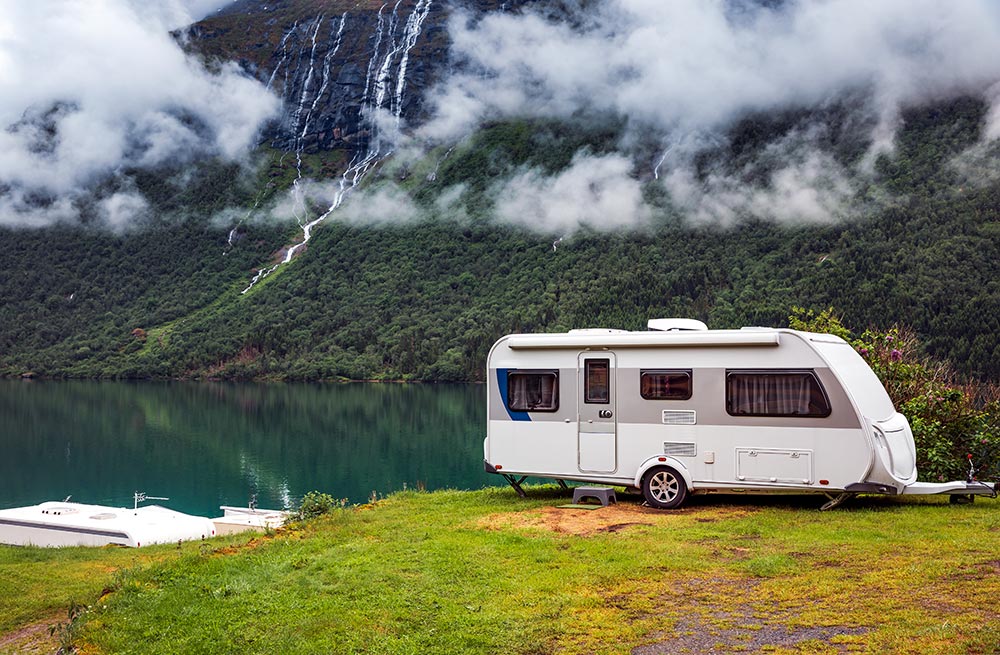
With winter on its way, now might be the time to give thought to storm-proofing your caravan and protecting it against the ravages of wind and rain.
Why are caravans at higher risk during storms?
You’ve only to compare the structure and materials used in the construction of a house versus a caravan to see why the latter is at higher risk. Caravans are manufactured from relatively lightweight materials, designed to be space-saving and compact.
Little wonder, then, that your caravan will be considerably more vulnerable to damage from the wind, rain, flooding, hailstones, and flying debris – all manner of risks that storm damage caravan insurance will need to acknowledge. Having the most suitable cover in place and preparing your caravan for the winter’s onslaught is critical.
How can I choose a safer pitch to reduce wind and rain damage?
Wherever it’s pitched, your caravan will be exposed to the elements, so careful site selection is a must, while you consider any natural forms of protection.
Do nearby buildings, hillsides, or treelines provide natural windbreaks, for example, what’s the direction of the prevailing wind and does the slope of the ground suggest safe drainage of your chosen site?
As the storm clouds begin to gather, you’ll realise that securing your caravan in windy weather starts with choosing the right pitch.
When should I take down or retract my awning in bad weather?
One of the most important precautions caravan owners can take is to remove or retract awning during storm warnings. It’s vital not to leave the decision too late – by the time winds become dangerously strong, it may no longer be safe to dismantle the awning. Acting early is always the safer and more sensible choice.
Insurers are also clear on this point. If your awning remains up during severe weather and suffers damage, any claim could be rejected on the basis that reasonable precautions weren’t taken. This type of exclusion is common in caravan insurance policies, so it’s important you understand your obligations.
Finally, don’t assume your awning is automatically covered under your standard caravan insurance. Many policies require awnings to be listed separately on the insurance schedule, so check your documents and speak to your caravan insurance broker if you’re unsure.
Further reading: Guide to awnings.
How can I prevent leaks and water ingress in heavy rain?
Preventing leaks and water ingress of your caravan in heavy rain is essentially a question of preparing for the winter ahead.
Without blocking the essential ventilation openings, check that the door and windows are not only firmly closed but that the sealant around all the frames remains watertight. Preparing for winter can become part of your annual maintenance routine.
Don’t forget to include – and keep up to date – a storm emergency kit for your caravan. The list of items for inclusion in any such emergency kit is not exhaustive but might certainly involve storm straps, ropes, a sturdy tarpaulin, first aid kit, torch, mobile ‘phone (and charger), and your caravan and motor insurance documents.
What exclusions should I check in my caravan insurance policy?
As with any kind of general insurance, always check your caravan insurance policy to make sure you meet the conditions. This might reveal certain caravan insurance policy exclusions such as unsecured awnings, belongings that have been left outside, or even a general failure to properly maintain your caravan.
Caravan insurance policy and exclusions may vary depending on the policy, so never assume that everything is covered. If you are unsure as to what your caravan insurance policy entails (and excludes), then speak to your insurance provider.
How can I make sure my caravan is storm-ready this season?
You’ve given the current insurance policy a once-over and you’ve prepared for the coming wind, rain, sleet, and snow of the coming winter.
Now you can relax in the knowledge that securing your caravan in windy weather and checking your caravan insurance policy gives peace of mind.

